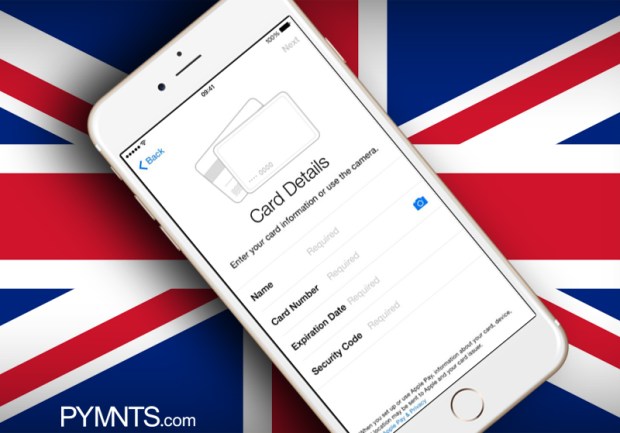Apple Pay’s UK Debut Hits And Misses

Like its U.S. launch last October, Apple Pay‘s dip across the pond had a few hiccups.
The highly anticipated launch in the U.K. yesterday (July 14) went relatively smoothly and garnered plenty of good press about how the U.K. might be the place that the mobile payment service can scale rapidly due to the population’s affinity for contactless payments. Apple Pay is said to work at 250,000 locations, a network which is anticipated to grow quickly.
“We actually think that the U.K. can be our leading market for Apple Pay, given the unique characteristics (of the market),” Jennifer Bailey, vice president of Apple Pay, told Reuters.
So what are a few of those hiccups? Well, for one, HSBC — which was anticipated to be an early adopter of Apple Pay — released a statement yesterday saying that it will not accept Apple Pay yet. This was a problem for some, of course, because it was widely reported that HSBC, as well as its Internet bank branch, first direct, would be accepting Apple Pay upon launch.
As was also seen in the U.S. launch, there seemed to be some confusion among consumers about which banks and which merchants are accepting Apple Pay.
According to a BBC report, HSBC was listed on Apple’s website on Monday (July 13) as a participating bank. But on the day Apple Pay actually launched, it was listed as “coming soon.” HSBC reportedly said it had never planned to take part in the initial rollout.
“We are working hard to bring this to our customers by the end of July,” an HSBC spokesperson told the BBC.
The banks that actually accepted Apple Pay (as of yesterday’s launch) are NatWest, Nationwide, Royal Bank of Scotland, Ulster Bank and Santander. Other major issuing banks expected to offer support by this fall include Bank of Scotland, Coutts, Halifax, Lloyds Bank, MBNA, M&S Bank and TSB Bank. It was also announced yesterday that Braintree will enable U.K. merchants — as well as merchants around the globe — to be among the first batch to accept Apple Pay in the U.K.
“Merchants and developers in the U.K. can now easily add Apple Pay to their checkout flow in addition to PayPal, credit and debit cards. At Braintree, we’re continuously expanding our platform to enable merchants to deliver the best commerce experiences, and our extension of Apple Pay support to U.K. developers furthers our mission to support multiple wallets,” Aunkur Arya, senior vice president of sales at Braintree, wrote in a company blog post.
Reports had surfaced that Barclays would support Apple Pay and that was also confirmed yesterday.
“We are really excited about the launch of Apple Pay and can confirm that we will bring Barclays debit cards and Barclaycard credit cards to Apple Pay in the future,” a Barclays spokesperson told TechCrunch.
As of now, 70 percent of all U.K. credit and debit cards support Apple Pay — which includes MasterCard, Visa Europe and American Express. Once Barclaycard joins, that number will increase to 82 percent, Bailey said.
“We have been surprised that so many banks have signed up to support Apple Pay,” Benjamin Ensor, an analyst at Forrester Research, told Reuters. “It’s worth asking what Apple Pay brings that the banks can’t do themselves.”
Another challenge Apple Pay faces, at least for the time being, is the contactless payments limit — currently set at £20 (roughly $31). That’s expected to raise to £30 ($46) in September. But it’s worth noting that that limit can be adjusted by retailers if they choose to do so. Apple doesn’t impose that limit, but most banks and businesses do.
Some food chains, like Pret a Manger and Bill’s, have chosen to do away with the contactless limits. Other U.K. merchants who accept Apple Pay include: Boots UK, BP, Costa Coffee, Co-op, KFC UK, Le Pain Quotidien, Liberty, LIDL, Marks & Spencer (M&S), McDonald’s UK, Nando’s, Post Office, SPAR, Starbucks, Subway, TfL, wagamama and Waitrose. A few expected to join later include: Screwfix, Wilko, EAT, Costcutter, Five Guys, JD Sports, Dune and New Look. The main grocery chains (Tesco, Sainsbury’s and ASDA) in the U.K. don’t accept Apple Pay yet.
Overall, most of the frustration from the U.K. launch — at least on social media — was aimed at frustration from iPhone users who have banks that don’t support Apple Pay. Other unconfirmed reports surfaced the Web about users who were being double charged from their bank on transactions (which also happened in the U.S. launch, but was quickly fixed).
[vc_row full_width=”” parallax=”” parallax_image=””][vc_column width=”1/1″][/vc_column][/vc_row][vc_row full_width=”” parallax=”” parallax_image=””][vc_column width=”1/1″][vc_separator color=”grey” align=”align_center” style=”” border_width=”” el_width=””][vc_single_image image=”148412″ alignment=”center” style=”vc_box_shadow_3d” border_color=”grey” img_link_large=”” img_link_target=”_blank” css_animation=”left-to-right” img_size=”full” link=”http://www.pymnts.com/whats-hot-today/”][vc_column_text css_animation=””]
To check out what else is HOT in the world of payments, click here.
[/vc_column_text][vc_separator color=”grey” align=”align_center” style=”” border_width=”” el_width=””][/vc_column][/vc_row]
